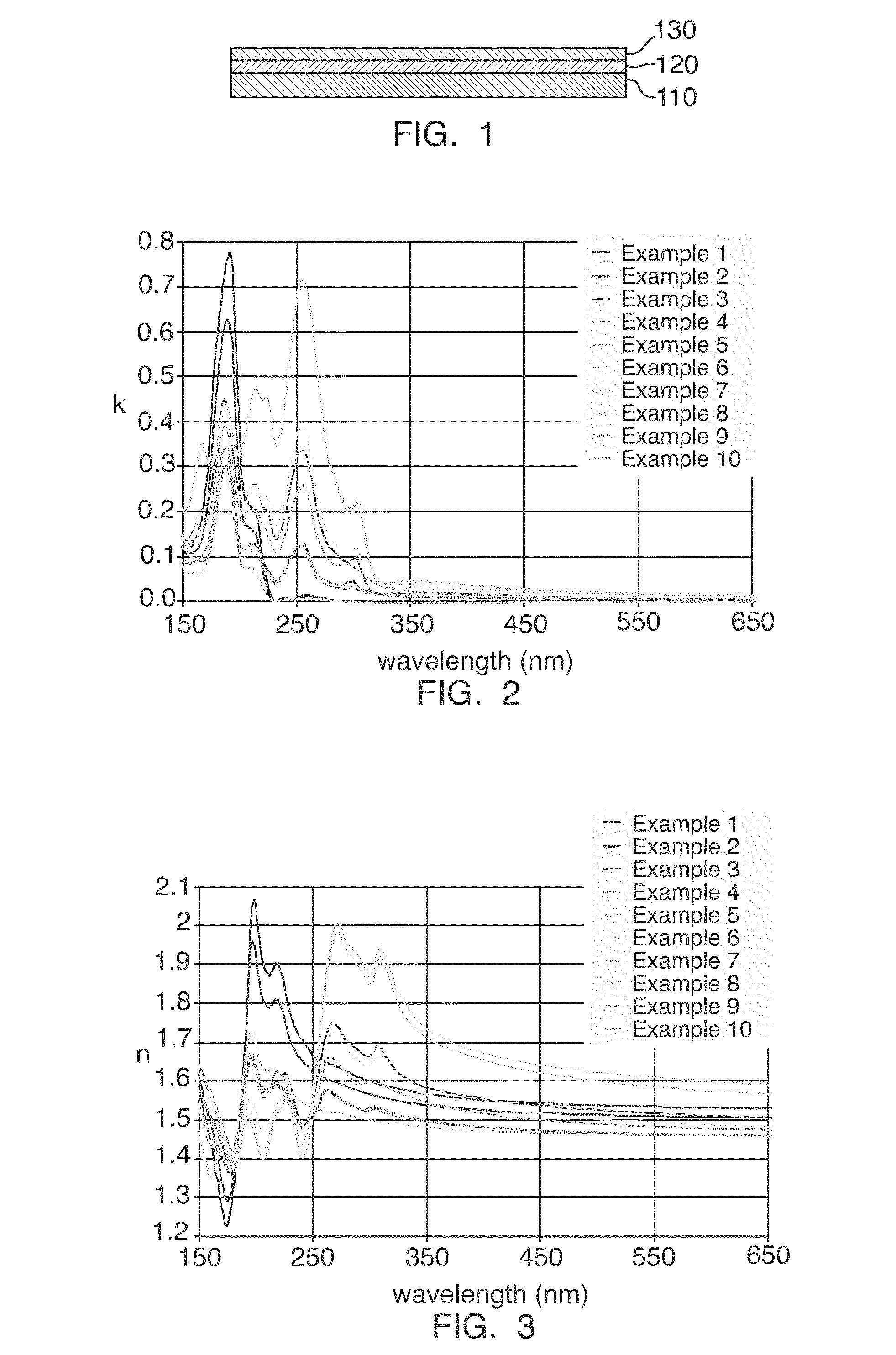Hybrid inorganic-organic polymer compositions for Anti-reflective coatings
a technology of organic polymer compositions and coatings, applied in the field of organic siloxane compositions and synthesis, can solve the problems of off-normal reflection effects and standing wave effects, destructive interference of light passing through the arc, and create challenges in manufacturing processes, etc., and achieve good mechanical and thermal properties
- Summary
- Abstract
- Description
- Claims
- Application Information
AI Technical Summary
Benefits of technology
Problems solved by technology
Method used
Image
Examples
example 1
[0140]Phenyltrimethoxysilane (14.04 g, 44 mol %), tetraethoxysilane (18.78 g, 56 mol %) were weighed to a round bottom flask. 65.64 g of acetone was added to the round bottom flask. 10.34 g of water (0.01 M HCl) was added to the reaction flask within 5 min, while constantly stirring the reaction mixture using a magnetic stirrer. After this the reaction mixture was stirred at RT for 27 min and refluxed for 5 hours using electric mantel. After the refluxing, most of the acetone was removed from the reaction mixture using a rotary evaporator (pressure 350->250 mbar, t(bath)=50° C.). After most of the acetone was removed, 72 g of PGMEA was added to the flask. The reaction mixture was evaporated further in the rotary evaporator (pressure 45 mbar, t(bath)=50° C., 1 hour) after PGMEA addition to perform a solvent exchange. After the solvent exchange the material solution was refluxed at 120° C. for 2 hours. After the 2 hour refluxing step the material is ready to use after dilution and fil...
example 2
[0142]Phenyltrimethoxysilane (9.57 g, 30 mol %), tetraethoxysilane (23.46 g, 70 mol %) were weighed to a round bottom flask. 66.06 g of acetone was added to the round bottom flask. 10.75 g of water (0.01 M HCl) was added to the reaction flask within 5 min, while constantly stirring the reaction mixture using a magnetic stirrer. After this the reaction mixture was stirred at RT for 27 min and refluxed for 5 hours using electric mantel. After the refluxing, most of the acetone was removed from the reaction mixture using a rotary evaporator (pressure 350->250 mbar, t(bath)=50° C.). After most of the acetone was removed, 72.07 g of PGMEA was added to the flask. The reaction mixture was evaporated further in the rotary evaporator (pressure 45 mbar, t(bath)=50° C., 1 hour) after PGMEA addition to perform a solvent exchange. After the solvent exchange the material solution was refluxed at 120° C. for 2 hours. After the 2 hour refluxing step the material is ready to use after dilution and f...
example 3
[0143]Phenyltrimethoxysilane (4.78 g, 15 mol %), tetraethoxysilane (23.46 g, 70 mol %) and Phenanthrene-9-triethoxysilane (8.24 g, 15 mol %) were weighed to a round bottom flask. 72.96 g of acetone was added to the round bottom flask. 10.75 g of water (0.01 M HCl) was added to the reaction flask within 5 min, while constantly stirring the reaction mixture using a magnetic stirrer. After this the reaction mixture was stirred at RT for 28 min and refluxed for 5 hours using electric mantel. After the refluxing, most of the acetone was removed from the reaction mixture using a rotary evaporator (pressure 350->250 mbar, t(bath)=50° C.). After most of the acetone was removed, 72.18 g of PGMEA was added to the flask. The reaction mixture was kept further in the rotary evaporator (pressure 45 mbar, t(bath)=50° C., 1 hour) after PGMEA addition to perform a solvent exchange. After the solvent exchange the material solution was refluxed at 120° C. for 2 hours. After the 2 hour refluxing step t...
PUM
| Property | Measurement | Unit |
|---|---|---|
| hydrolysable | aaaaa | aaaaa |
| composition | aaaaa | aaaaa |
| molecular weight | aaaaa | aaaaa |
Abstract
Description
Claims
Application Information
 Login to View More
Login to View More - R&D
- Intellectual Property
- Life Sciences
- Materials
- Tech Scout
- Unparalleled Data Quality
- Higher Quality Content
- 60% Fewer Hallucinations
Browse by: Latest US Patents, China's latest patents, Technical Efficacy Thesaurus, Application Domain, Technology Topic, Popular Technical Reports.
© 2025 PatSnap. All rights reserved.Legal|Privacy policy|Modern Slavery Act Transparency Statement|Sitemap|About US| Contact US: help@patsnap.com



